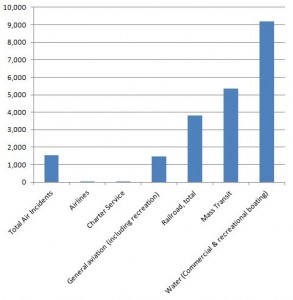
Click to enlarge. We didn't even include highway/motorist accidents on this chart, because it would blow the scale completely out of proportion.
As a matter of fact, travel by air continues to be the safest mode of travel. Which makes it ironic when I hear people say they are “going to drive” because they have a “fear of flying”.
Two interesting statistics about flying are:
- Your chance of being killed on a flight is roughly 8 million to 1. Another way of looking at it is it would take you roughly 21,000 years to be killed in air travel.
- You are more likely to die as a pedestrian, on a motorcycle, in a car, in a bus, on a watercraft, and my favorite, riding an animal! That’s right, you are more likely to die riding an animal than you are flying an airplane.
Here are NTSB’s latest statistics on transportation accidents by mode of transportation:
| Transportation Accidents by Mode | |
| Total Air Incidents | 1,553 |
| Airlines | 30 |
| Charter Service | 49 |
| General aviation (including recreation) | 1,474 |
| Railroad, total | 3,807 |
| Mass Transit | 5,360 |
| Water (Commercial & recreational boating) | 9,188 |
| Highway, total crashes | 5,505,000 |
There are several factors that make air travel, private air travel in particular, so safe:
 Your private aviation charter company is constantly being scrutinized by third party auditing companies. Two popular ones are ARG/US and Wyvern. These reports are available to you as the client and include – complete, in depth safety reports on your charter operator, pilot experience and historical safety ratings, pilots certificates, aircraft registration,operator certificate,accident and incident reports, ownership and management. Make sure you look for operators with these endorsements.
Your private aviation charter company is constantly being scrutinized by third party auditing companies. Two popular ones are ARG/US and Wyvern. These reports are available to you as the client and include – complete, in depth safety reports on your charter operator, pilot experience and historical safety ratings, pilots certificates, aircraft registration,operator certificate,accident and incident reports, ownership and management. Make sure you look for operators with these endorsements.- All flights are required to operate under the Federal Aviation Administration’s part 135 standards, which establishes the guidelines for safety, maintenance, and operations.
Operating at the safety standard the FAA requires is a minimum, from there the standards are raised higher with third party vendor auditing, insurance requirements, and company standard operating policies (SOP’s). All of these work together to permeate a culture of safety within a given flight department. Do your due diligence when selecting a charter company. Meet with them, ask about their accident/incident record, ask to see their ARG/US or Wyvern endorsements, and make that a bigger priority than what type of aircraft you will be selecting.
What about security? Is private aviation more secure than flying commercial? The simple answer is yes. Private air travel is more secure because:
- Full privacy on your flight that enables executives to conduct meetings and work uninterrupted – something not possible flying commercial.
- Avoids crowded lines, crowded terminals, and gets you closer to your specific destination.Private aviation accesses over 5,000 airports compared with the airlines that serve around 500 airports – that means less time getting to your destination.
- Private aviation is available 24/7/365 – your schedule, not the other way around.The FAA has enhanced security regulations at private airports.
- If the nature of your travel requires security personnel, that can be arranged through various law enforcement agencies.
- Passengers are always with their belongings, so there is no reason to worry that luggage will be damaged or sent to the wrong city.
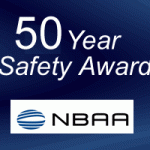
There is not a safer or more secure way to travel than with private aviation.
Special Services is a proud recipient of the NBAA’s 50 Year Safe Flying Award. In business since 1958, Special Services extends the advantages of a full-time flight department to individuals and companies alike, at a part-time cost. Our stated mission is – “Safety, Integrity, Convenience, Economics, and Professionalism.



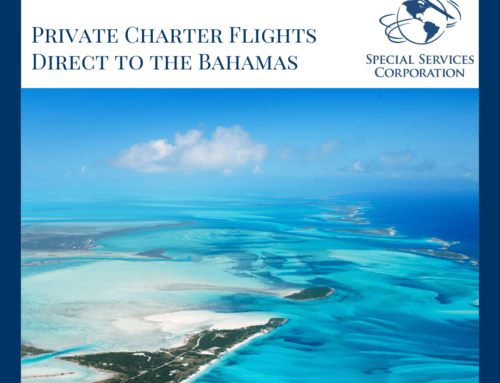
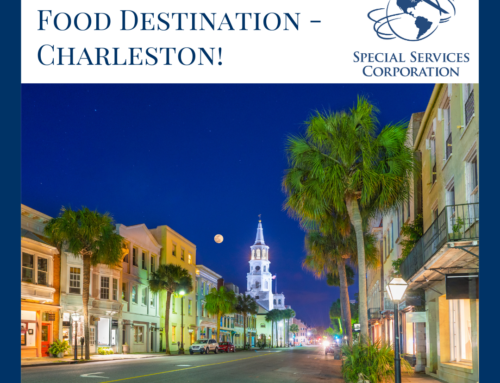
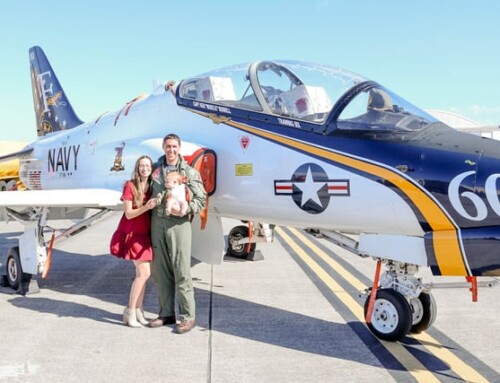
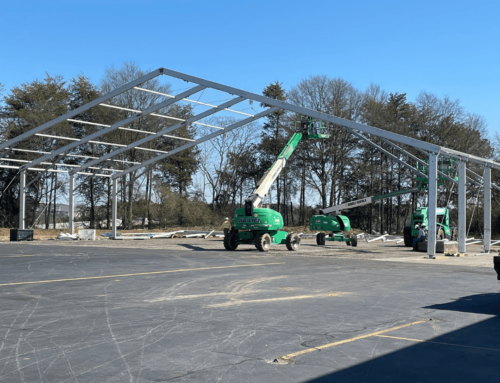

Leave A Comment